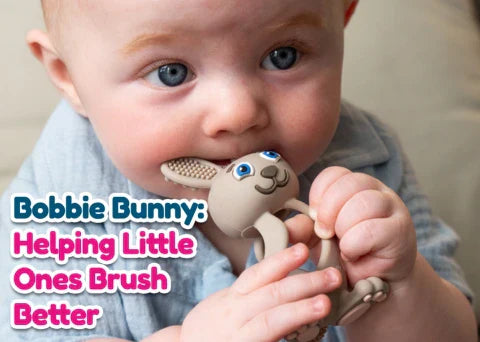The Truth About Teething Symptoms

Teething is the process by which an infant's first teeth ("baby teeth”/milk teeth") emerge through the gums, typically arriving in pairs. Teething may start as early as 3 months and as late as 12 months, but generally, first teeth appear between 6 and 9 months.
Let's expose the myths and explain some truths about teething:
Teeth do NOT ‘cut’ through the gums
Biologically babies’ teeth do NOT ‘cut’ through the flesh of gums. Instead, special chemicals are released causing the cells in the gums to separate and recede, allowing the new teeth to come through.
This process should not be painful although there may be some discomfort which is why toddlers like to chew on the area and often accompanied by drooling due to increased saliva levels, which is good as this help to flush the area and keep gums clean.
So what causes the pain?
Pain during teething is generally due to inflammation and infection of the GUM tissue which can be caused by bacteria and food deposits getting caught in tiny gum flaps around the emerging tooth. Therefore, the best way to try and prevent teething pain is to keep gums and new teeth as clean as possible. You could also try our brush baby teething wipes which contain an anti-inflammatory that helps fight the pain!
What about traditional teething remedies for babies?
Medicines are often applied to the babies' gums to relieve swelling and pain, working as a ‘numbing agent’ to dull the nerves in the gums so that pain is less noticeable. However, these only address the symptoms, so the pain is likely to return until the problem is addressed, i.e. the bacteria irritating the gums.
Teething doesn’t cause illness!
Teething does not cause illness. It can coincide with the time that toddlers are losing their protective maternal antibodies against infection and building up their own and at this time they can be more susceptible to infection and minor illness. To help soothe your teething baby, shop our range of baby teethers here.
How to help prevent the pain
- Clean gums every day to reduce bacteria and food deposit build-up by using a clean gauze and cooled, boiled water or specially designed baby Baby Dental Wipes.
- Brush teeth as soon as they appear and continue to clean gums with a regular Childrens Toothbrush, or use a specially designed Chewable First Baby Toothbrushes which cleans both teeth and gums.
- When brushing teeth always make sure you use an appropriate-sized kids toothbrush and only a SMEAR of age-appropriate fluoride baby toothpaste.







